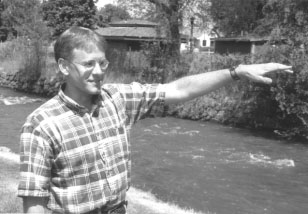Baker County Comes Back
November 15, 2020
The excerpts below are from a special report of the Meyers Memorial Trust, written by Marie Deatherage. The full report can be read here.

Standing beside the Powder River in Baker City, Brian Cole explains how the Leo Adler Memorial Parkway will provide a foot and bike path to residents.
“If there was ever a person who didn’t live in Baker County who had an impact in Baker County, it was Neil Goldschmidt,” explains Brian Cole, now chairman of the Baker County Board of Commissioners, who earlier served as director of the Baker City/County Economic Development Department.
…
Baker County was one of the first to begin developing a regional strategy. In early 1987, it hired its first economic development staff. Brian Cole, a recent business graduate of Willamette University, set about developing a strategic plan for the county’s comeback, which the county adopted later that year. The plan had four distinct phases and was based on first developing a tourist industry. Visitors would find the place so inviting and desirable, they would decide to move to Baker County, bringing their businesses and jobs with them.
…
The Oregon Trail Interpretive Center opened its doors in May 1992, just in time to join in the national sesquicentennial celebration. According to Brian Cole, the completion of OTIC was significant in two ways. First, it brought more than 1.2 million tourists to Baker County over the next several years and developed a significant tourism industry.
…
From 1994-98, following his position with Baker County, Brian Cole worked in the Oregon Economic Development Office, “watching communities across the state work or not work, evaluating their ability to envision projects and get them done.” Based on his observations, Cole came up with a four stage model of community development, which he explains by applying it to Baker City.
…
Brian Cole summarizes Baker City’s Stage 3 development this way: “By 1996, we had several good projects chasing money, sometimes competing with each other for the same funds. At that point, we ran the risk of going back to Stage 2 rather than on to Stage 4.” The first round of Leo Adler Community Development grants was announced in December 1995, the allocations consistent with the many contributions that he had made to his community during his lifetime.
…
By February 1996, according to Brian Cole, community leaders noted that while the decisions made by the Leo Adler trustees were “all meritorious decisions, there was a ‘disconnect’ between those funding decisions and the ‘strategic direction’ for the communty.” A touching illustration of the local sense of community came when Tabor Clarke and Brian Cole were showing me plans for the Leo Alder Memorial Parkway along the Powder River, midday on a Monday. Two teenage boys on skateboards were hanging out along the river bank, and came over to find out what we were doing there. Tabor Clarke told them about the planned project, then asked why they weren’t in school at that time of day.
…
Brian Cole and Roger Lee, current director of the Baker Economic Development Department, are given much of the credit for making new businesses feel welcome in the county and for minimizing the bureaucratic difficulties that are legend in many communities.
…
In 1998, Partnership II received $154,800 from the Leo Adler Foundation to begin its work. Brian Cole serves as a liasion between both Partnership groups.
…
These statistics paint a mixed portrait. After many years of decline, Baker County’s population in 1998 finally climbed back above its 1950 level. Despite the loss of several major industries and every one of its lumber mills, Brian Cole reports there are over 500 more jobs in Baker County now than in 1979 before the bottom fell out of the timber industry (see graph at left). Cole also points out that Baker County’s per capita income growth between 1988 and 1996 was the fourth fastest in the state and its unemployment rate has been more than halved, despite the loss of its largest manufacturing employer (and last lumber mill) in 1996.
…
According to Brian Cole, “Destination Downtown” has been so successful that over the past two years it has nearly matched the visitor level of the Oregon Trail Interpretive Center.
